REFLECTIONS ON THE
MOTIVE POWER OF FIRE

Sadi Carnot at the age of 34.
REFLECTIONS ON THE
MOTIVE POWER OF FIRE
SADI CARNOT
and other Papers on the Second
Law of Thermodynamics by
. Clapeyron and R. Clausius
Edited with an Introduction by
E. Mendoza
DOVER PUBLICATIONS, INC.
Mineola, New York
Copyright
Copyright 1960, 1988 by Dover Publications, Inc.
All rights reserved.
Bibliographical Note
Reflections on the Motive Power of Fire is an unabridged and slightly corrected republication of Reflections on the Motive Power of Heat by Sadi Carnot, translated and edited by R. H. Thurston, and published by Macmillan and Company in 1890. Additional footnotes by E. Mendoza are initialled E. M. A new Appendix, Selections from the Posthumous Manuscripts of Carnot, translated by R. H. Thurston and E. Mendoza, has been added.
Memoir on the Motive Power of Heat by . Clapeyron was especially translated for this edition by E. Mendoza.
On the Motive Power of Heat, and on the Laws which can be Deduced from it for the Theory of Heat by R. Clausius was translated by W. F. Magie, and originally appeared in the volume entitled The Second Law of Thermodynamics edited by W. F. Magie, and published by Harper and Brothers in 1899.
E. Mendoza edited and wrote the Introduction to this Dover edition.
This is a new edition of the work first published in this form by Dover Publications, Inc. in 1960.
International Standard Book Number: eISBN 13: 978-0-48617-454-9
Manufactured in the United States of America
Dover Publications, Inc., 31 East 2nd Street, Mineola, N.Y. 11501
Contents
Illustrations
Introduction
 1. Sadi Carnot. The beginning of the nineteenth century was a time which resembled our own in many ways. Men were aware that it was a period of transition and that they were entering a new erathe age of steam power and the age of iron. The first, and at the time the most important use of the new motive power was for driving pumps for draining coal mines; coal was desperately needed by both England and France for making the coke required for smelting iron. A secondary use was for driving machinery (the bellows and rolling mills of the iron works, the paddles of steamboats); a use which the recent invention of various cranking mechanisms had made possible. In exploiting these applications, England, relying on the genius of engineers who had no formal training whatever, was well ahead of France. The French realized that Englands prosperity in peacetime and her invulnerability in war were both due to her industrialization. In France there was a great awareness of the growing importance of science, and there, for perhaps the first time in history, a real attempt was made to give engineers and scientists a specialized formal training, while the more enlightened of her governments sponsored quite elaborate researches.
1. Sadi Carnot. The beginning of the nineteenth century was a time which resembled our own in many ways. Men were aware that it was a period of transition and that they were entering a new erathe age of steam power and the age of iron. The first, and at the time the most important use of the new motive power was for driving pumps for draining coal mines; coal was desperately needed by both England and France for making the coke required for smelting iron. A secondary use was for driving machinery (the bellows and rolling mills of the iron works, the paddles of steamboats); a use which the recent invention of various cranking mechanisms had made possible. In exploiting these applications, England, relying on the genius of engineers who had no formal training whatever, was well ahead of France. The French realized that Englands prosperity in peacetime and her invulnerability in war were both due to her industrialization. In France there was a great awareness of the growing importance of science, and there, for perhaps the first time in history, a real attempt was made to give engineers and scientists a specialized formal training, while the more enlightened of her governments sponsored quite elaborate researches.
One of the most important of the institutions established in the course of this movement was the cole Polytechnique, founded in 1794 as a training school for army engineers. A list of men associated with its early period, before 1830, reads like the index of a book on mathematical physics. Among the first instructors were Lagrange, Fourier, Laplace, and Berthollet, Ampre, Malus and Dulong; among former students who stayed on as instructors were Cauchy, Arago, Dsormes, Coriolis, Poisson, Gay-Lussac,; Petit and Lam; other students included Fresnel, Biot, Sadi Carnot, Clapeyron and the physiologist Poiseuille. It was this generation which largely formulated the attitudes and procedures of mathematical physics as we know it today. The terms Lagrangian, Laplace transform, Poissons equation, Fourier integrals, Cauchy relations, Fresnel coefficients, Coriolis forces conjure up a picture of an era when it seemed that the understanding of nature was merely a question of writing down equations and of inventing methods for solving them.
But there was another aspect of the work of this extraordinary group of scientists. Possibly because of their connection with an army which conquered most of Europe, possibly because they lived in such a time of discovery and transition, almost all of them saw their science as only one part of their lives. While being masters of pure science, they applied their astonishingly varied talents to very different problems. For example, students of history think of Fourier not as a mathematician but as one of Napoleons generals in Egypt. Again, Clment and Dsormes published three papers in the same volume of the Journal de Physique for 1819: one described their work on the specific heats of gases and the absolute zero of temperature; the second was an assessment of the-food requirements of the country with proposals for the storage of dehydrated grain in wrought-iron granaries; and the third dealt with the relative merits of coal-gas and oil for domestic lighting. Clapeyron and Lam built some of the first railroads in France, and were responsible for much of the organization of technical education in Russia.
One of the outstanding men of this generation, one of the great men of history, was Lazare Carnot. He was the man who appointed Napoleon to his first independent command, who organized the fourteen armies which for a time conquered Europe, who planned every campaign and who, at Antwerp, remained the only one of Napoleons generals to be undefeated. In addition, he was an excellent mathematician. He wrote on abstract geometry and on the logical problems of the calculus, but from our present point of view it is more interesting to recall a mathematical work entitled Fundamental Principles of Equilibrium and Movement, published in 1803. It is a discussion of the efficiency of machinesmachines in the old sense, that issuch as pulleys and inclined planes. His contribution was to see through all the details of the mechanisms and to develop a much more general discussion based on what we should now call the conservation of mechanical energy. It seems trivial enough to us now, but in those days it must have been a very bold approach. As late as the 1830s, the term Carnots theorem denoted a statement that in any machine the accelerations and shocks of the moving parts all represented losses of moment of activity, that is, of the useful work done; from this Carnot drew the inference that perpetual motion was impossible.
In 1796, when Lazare Carnot was one of the Directory of France, a son was born. He was named Sadi after a mediaeval Persian poet and moralist, Saadi Musharif ed Din, whose poems had enjoyed something of a vogue. A few years later Lazare was Minister of War and he often took his small son with him when he visited Napoleon. It is recorded that one afternoon Napoleons wife and some other ladies were in a boat on a lake and Napoleon was amusing himself throwing stones near them and splashing them; they dared not protest. Sadi, all of four years old, ran up and shook his fist, shouting: You beastly First Consul, stop teasing those ladies! Luckily for the history of physics, Napoleon roared with laughter.
Till he was about 16, Sadis education was directed by his father; but after that time they were able to see one another only on the briefest occasions. Sadi entered the cole Polytechnique in 1812the year when Napoleons fortunes turned, the year of his retreat from Moscow. By the time Sadi was finishing his courses of study, in 1814, Paris itself was being besieged. The students of the cole Polytechnique petitioned to be allowed to take part in the defence of the city; 250 of them were sent to a skirmish against the Prussians at Vincennes. They had 28 cannon and fought bravely enough, repelling several charges, but what looked like a relief force turned out to be a regiment of Russian lancers and the contingent retired in confusion, though with no losses.

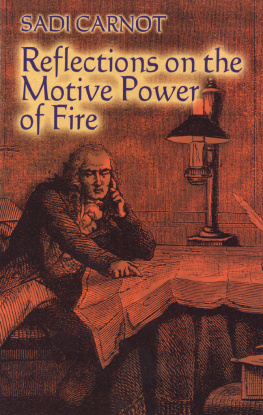




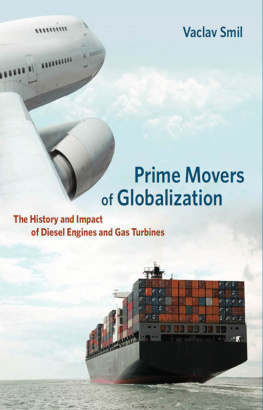

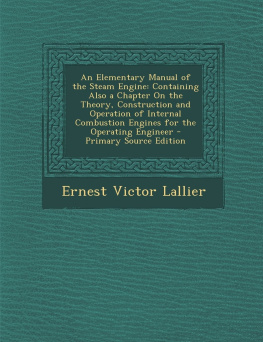
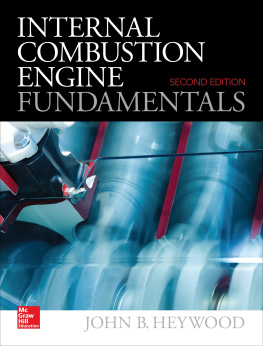

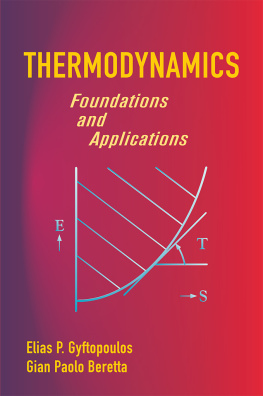


 1. Sadi Carnot. The beginning of the nineteenth century was a time which resembled our own in many ways. Men were aware that it was a period of transition and that they were entering a new erathe age of steam power and the age of iron. The first, and at the time the most important use of the new motive power was for driving pumps for draining coal mines; coal was desperately needed by both England and France for making the coke required for smelting iron. A secondary use was for driving machinery (the bellows and rolling mills of the iron works, the paddles of steamboats); a use which the recent invention of various cranking mechanisms had made possible. In exploiting these applications, England, relying on the genius of engineers who had no formal training whatever, was well ahead of France. The French realized that Englands prosperity in peacetime and her invulnerability in war were both due to her industrialization. In France there was a great awareness of the growing importance of science, and there, for perhaps the first time in history, a real attempt was made to give engineers and scientists a specialized formal training, while the more enlightened of her governments sponsored quite elaborate researches.
1. Sadi Carnot. The beginning of the nineteenth century was a time which resembled our own in many ways. Men were aware that it was a period of transition and that they were entering a new erathe age of steam power and the age of iron. The first, and at the time the most important use of the new motive power was for driving pumps for draining coal mines; coal was desperately needed by both England and France for making the coke required for smelting iron. A secondary use was for driving machinery (the bellows and rolling mills of the iron works, the paddles of steamboats); a use which the recent invention of various cranking mechanisms had made possible. In exploiting these applications, England, relying on the genius of engineers who had no formal training whatever, was well ahead of France. The French realized that Englands prosperity in peacetime and her invulnerability in war were both due to her industrialization. In France there was a great awareness of the growing importance of science, and there, for perhaps the first time in history, a real attempt was made to give engineers and scientists a specialized formal training, while the more enlightened of her governments sponsored quite elaborate researches.